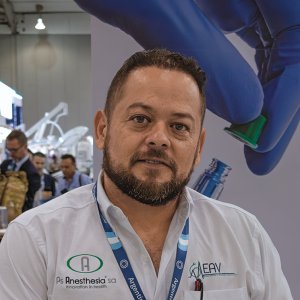Texting for Healthier Behavior

STORY INLINE POST
Q: How is UNICEF’s partnership with the Mexican government contributing to the Prospera Digital strategy?
A: The Prospera Digital strategy we are working on targets mothers and pregnant women. For Prospera Digital, UNICEF provides our rapid growth technology and original content we have developed on breastfeeding, early child development, signs of concern during pregnancy and so on. UNICEF has developed a technological tool called RapidPro, a development app we use for different kinds of interventions and to create information flows from and for people. Our experience on Communication for Development (C4D) and our technology is what makes us an invaluable partner for the federal government on the Prospera Digital strategy.
The content we provide is designed jointly with users. We conducted ethnographic research with the beneficiaries of Prospera, going to several communities to identify which were the main obstacles they faced in terms of healthcare. Most of the time, the obstacles they face are related to the long distances they have to travel to get to the closest health clinic. Sometimes when they have an emergency it takes them three or four hours to get to the clinic. Another difficulty they face is at the moment of child delivery. Sometimes a women will get to the clinic but because she is not that far into labor she has to wait and is sent back to her house.
Prospera’s beneficiaries are a vulnerable group and unfortunately they suffer from the highest rate of stillbirth and of high maternal mortality. Based on these situations we decided to create this intervention, working with the Mexican government and its National Digital Strategy office. They provided us access to Prospera and to the Ministry of Health.
RapidPro has three different treatment groups and one control group. The first treatment is focused on sending messages with content aimed at changing beliefs, attitudes and practices during pregnancy and identifying different signs of concern. Our interaction goes beyond sending push notifications, or one-way messages. The RapidPro tool helps us obtain information from the beneficiaries, which assists us on the catering of specific solutions for their needs. For instance, we ask mothers with babies of breastfeeding age how many times a day they breastfeed their babies or how many times a day they change the baby’s diapers. If we notice that it is less than eight times we can allocate them to a group that has low rates of breastfeeding and we begin a process of sending messages that try to reinforce the importance of breastfeeding and then track their progress.
The second treatment group receives the same kinds of messages but we also send messages to community health promotors that participate with Prospera. We ask them to reinforce the messages the women in their communities receive through their phones. These community health promoters also have the capability of sending more messages to the pregnant women that help with reinforcement of the message we are sending. It is a mobile initiative with a strong health community component aimed at reinforcing information.
The third treatment group also receives the messages but the mothers are also able to assess the quality of the healthcare they receive in the clinics. The women are asked for specifics regarding the attention they have received from their doctors and the treatment they need depending on their pregnancy stage or their baby’s age. With this information we are able to shorten the route of accountability, in which beneficiaries are directly able to evaluate the quality of the service they receive. With all the information we gather we try to allocate positive incentives for doctors’ good work, such as extra vacation days. Our control group is also with Prospera beneficiaries but they are on the traditional Prospera plan and only receive their conditional cash transfers.
There are 3,000 beneficiaries on the three treatment programs and 3,000 on the control group. Our 6,000 beneficiaries are being treated at 655 clinics. We are deploying the program on the states of Mexico, Chiapas, Hidalgo, Puebla and Guanajuato. These five states were chosen because they present a mixture of the different conditions in Mexico and because they present a high ratio of maternal mortality rates. With this information we will obtain data that will inform us on the scope of the program and after the implementation of the program we will have outcome results from the impact evaluation.
The messages we send to all treatment groups cover an array of topics such as prevention during pregnancy, labor, breastfeeding, early child development and content to prevent accidents during the first two years, all aimed at changing the mother’s behavior. The messages also ask them if they know where their nearest clinic is and how are they planning to get to the clinic when their baby is born. We ask them to design a plan for their delivery day and a back-up plan for that day. We also ask them how much money they believe they are going to spend on delivery day and provide them with a money-saving plan so they can have funds available when the time comes.
Q: What participation and engagement rates are Prospera Digital seeing?
A: The project was launched last December and we are still going through the implementation process. It has been going for around seven months. In the next two months we will have the first preliminary results and at the end of the year we will get information on how the program is changing baby’s sizes at birth, weight, height and Apgar scores. Those are our final outcome outputs. The midterm outcomes we have been tracing are engagement and participation rates. Our latest measurement shows an average engagement rate for our three groups of 87 percent.
We send different kinds of messages. Some messages only provide information while other messages are questions designed for us to collect information so we can cater options to that mother’s specific needs. Our participation rate is based on the response to those questions. There is an average response to 85 percent of the messages we send. The preventive messages also have two variants, the informative ones and the ones that look for a response. With those messages we have a 70 percent response. For the messages we send that are looking for warning signs we receive around an 87 percent response. The messages asking for the quality of the healthcare they receive are having an 80 percent response.
Our messages receive high response rates at the beginning but the engagement levels tend to decrease as time goes by. We are working on ways to maintain the participation rates. Prospera beneficiaries have to attend different workshops as part of the conditional cash transfers they receive and one of those workshops is Prospera Digital, where we invite pregnant women to participate. In the workshops the team implementing the program explains how it works, how to use their cellphones and if they do not have a phone we provide them with a basic cellphone. We have found that in the first four months participation is high because it is something new and they are enthusiastic.
Around 45 percent of the women who participate are 23 years old or under. Our strategy for maintaining the participation rates of this particular group after the first four weeks is to create Facebook Messenger multimedia content. It is a strategy that we believe will increase participation rates. Our Facebook page also is filled with interesting content created by UNICEF, the Ministry of Health and our partners regarding breastfeeding, child development and anecdotes from people who have used the program. The goal is to make the program personal for all the women who participate.
Q: Which alliances did UNICEF forge to develop the program?
A: The President’s office as well as representatives from the National Digital Strategy helped us with the process of bringing together private sector players. The equipment or hardware we give the women is provided by Alcatel and Samsung. Telcel and Movistar Telefónica are helping us with the text messaging. Telcel gave us 2 million free text messages for an eight-month period and Telefónica gave us 6 million free text messages for one year. Their participation has been crucial for us. That is why the partnership with Facebook is so important. Its Internet. org can definitely help us to achieve our goal of carrying information to a population group that has no access to other mobile technologies.























